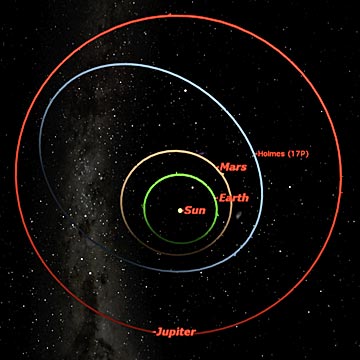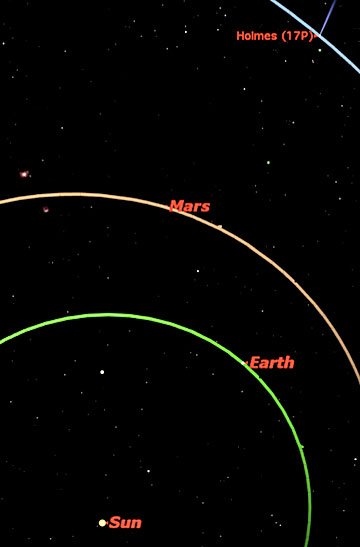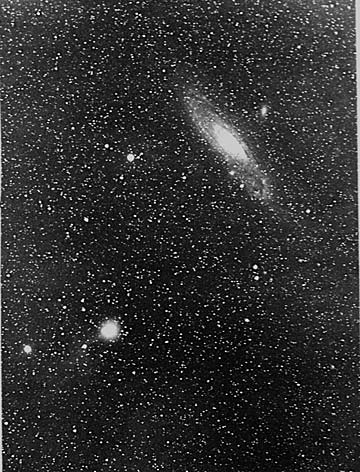
The recent dazzling brightness of periodic Comet 17P/Holmes has continued to captivate comet watchers throughout the Northern Hemisphere. Only a couple comets each decade are this easy to see.
 Orbital positions on 2007 October 23, when the Holmes outburst occurred. All the planets and the comet are moving counterclockwise around the Sun from this view from above the Sun's north pole.
Orbital positions on 2007 October 23, when the Holmes outburst occurred. All the planets and the comet are moving counterclockwise around the Sun from this view from above the Sun's north pole.
Since its explosive outburst on Oct. 23, Comet 17P/Holmes has been putting on a unique display, looking very different than any other comet of our generation: its head—called the coma—appears like a round, yellowish fuzz ball in the constellation Perseus, and is visible for most of the night. Following its dramatic increase in brightness, Comet 17P/Holmes has shone almost consistently between magnitudes 2 and 3, making it similar in brightness to the stars that make up the famous Big Dipper. However, its brightness has already begun to diminish somewhat.
 This diagram helps us to understand what's going on with Holmes' tail
This diagram helps us to understand what's going on with Holmes' tail
In recent days, scientists have observed through astrophotography that Comet 17P/Holmes appears to have grown a tail. However, the tail cannot be readily seen, even with binoculars. Only long-exposure astrophotography reveals a stubby ion tail which, from Earth's perspective, is being blown away from the comet's nucleus.
Use the "W" as a guide
You can find Comet 17P/Holmes by using the "W" of Cassiopeia as your guide. The five stars in a conspicuous zigzag pattern are high in the northeast sky during the mid-evening hours.
Draw an imaginary line from the star Gamma Cass down to Delta Cass (known also as Ruchbah). Extend the line downward about five times the distance between these two stars and you'll come very close to where Comet 17P/Holmes is. Initially, the comet formed a triangle with Alpha Persei (known also as "Mirfak") and Delta Persei. More recently, Comet 17P/Holmes has been slowly changing its position, climbing higher in the Northeastern sky, toward Cassiopeia.
If you have binoculars, you'll know the comet immediately when you see it: a small, albeit distinct, circular lemon-yellow cloud of light. A small telescope will help bring out the fuzzy details.
Varying Moon phases may hinder comet viewing to a degree. The ideal time to view Comet 17P/Holmes is when the Moon is new, or appears as a crescent. This will ensure the darkest sky for optimum comet watching.
 Comet Holmes photographed on 1892 November 10 by E. E. Barnard. The Andromeda Galaxy is at upper right, Mu Andromedae at lower left, with the comet just to the right of it.
Comet Holmes photographed on 1892 November 10 by E. E. Barnard. The Andromeda Galaxy is at upper right, Mu Andromedae at lower left, with the comet just to the right of it.
Reports from around the world
Long Island, NY amateur, Bryan Bradley writes: "I went out the past two nights and observed the comet from my driveway observatory. Very interesting how bright it has become. My daughters also saw it with me and commented that it looked like a big fuzzy ball, but where is the tail?"
Another Long Island amateur observer, Rich Tyson relates that "My wife Antoinette described Comet 17P/Holmes as looking like a "fried egg." Can we call it the 'Fried Egg Comet?'"
Well-known comet observer John Bortle, of Stormville, NY, has carefully scrutinized the comet on a number of nights with a variety of different instruments. He saw the comet on the evening of Oct. 28 without the glaring Moon in the sky. "So much info was recorded I can't begin to report more than a fragment of it here. A double envelope feature surrounding the comet is truly spectacular in the darker sky."
Similar raves were coming in from other places around the globe.
Eddie Guscott from Essex, England had been trying to see Comet Holmes since it exploded into view, but " . . . the weather here has been dire: 100-percent cloud. So it was a great surprise to finally get an hour of clear weather enabling me to observe this wonderful sight. I have never seen anything like it before."
Robert McNaught, discoverer earlier this year of a spectacular daylight comet that bears his name, observed Comet 17P/Holmes from Siding Spring, Australia.
"The comet was a surprisingly easy naked eye object despite the near-full moon sitting above it," McNaught said of comet 17P/Holmes. "Lovely views in the Uppsala's 6-inch finderscope at 80x showing the faint stellar condensation and 'an' within the large 'planetary nebula'-like coma. Very impressive."
What caused the outburst?
Theories vary as to what may have caused the comet?s eruption. Some astronomers think it might be due to a rich vein of volatile ices on the comet's nucleus that was suddenly exposed to sunlight. This is actually the second time that Comet 17P/Holmes has flared up in this manner, the last time coming in its discovery year of 1892.
John Bortle (quoted above) suggested the nucleus of Comet 17P/Holmes might consist of low-density material that, over time and through outgassing, develops a large region with a very tenuous structure, perhaps honeycomb-like.
"Cometary nuclei being irregular in shape, rotation or perhaps even the minute gravity of the nucleus itself will create increasing shear forces if the area is remote from the center of rotation," Bortle said. "At some point, the highly fragile bonds connecting the honeycomb of material will reach the failing point and a collapse, or more likely a sudden crushing/consolidating event on a grand scale perhaps covering several square kilometers wide and deep, will occur. This crushing collapse would expel a truly gigantic volume of dust in the process."
Another outburst possible?
The show could have a reprise later this year.
"Those who are familiar with terrestrial structural collapse situations are aware that the primary event often leaves a large amount of instability in the material involved," Bortle said. "This remaining instability will only remain for a short time before a further adjustment toward stability occurs, resulting in a major second collapse, with an outward physical appearance very similar to that of the initial event."
Back in 1892, Comet 17P/Holmes underwent a second outburst about 75-days after the first.
Will there be a "cosmic aftershock" that will again cause the comet's brightness to again spike a similar number of days after the big Oct. 23 outburst this year? Bortle thinks it's a possibility.
"I would urge everyone to watch very carefully for a possible repeat of this secondary event about the turn of the year," he said.
December 2007















